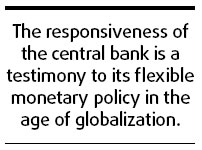Interest rate cut may hint at future trend
The central bank made an abrupt decision on Monday to reduce the benchmark loan interest rate and the reserve requirement ratio for commercial banks.
The move is intended to ensure steady and rapid economic growth.
The benchmark interest rate for one-year lending was lowered by 0.27 percentage points from Tuesday - its first downward movement since October 2004 - and the rate for deposits remains unchanged. At the same time, the ratio deposit lenders are required to set aside will be cut by 1 percentage point from Sept 25.
The 1 percentage point cut from the reserve requirement ratio does not apply to the country's major lenders. In addition, the reserve requirement ratio will be reduced by 2 percentage points for local financing institutions in the areas most devastated by the May 12 earthquake.
The latest downward adjustment in the lending interest rate and the reserve requirement ratio was made against a backdrop in which some problems with the US investment bank Lehman Brothers and other financial bodies were exposed.
The People's Bank of China's response to the international financial upheaval was rapid. The powerful impact of Lehman's filed bankruptcy and Merrill Lynch's consent to be purchased by Bank of America is expected to spread to other financial markets.

The responsiveness of the central bank is a testimony to its flexible monetary policy in the age of globalization. It also demonstrates the bank is vigilantly monitoring changes in the international financial market. Now, the central bank places high on its priority list the development of monetary policies befitting the international context.
These adjustments are a signal to the market from the central government that it is starting to ease the nearly yearlong period of tightened monetary policy - doing so within a context of turbulence within the international financial market, a slowing of domestic economic growth, a plummeting stock market and a declining CPI.
The move is intended to prevent the economy from sliding further and to ensure the national economy's steady and rapid development. It could also herald an about-face in the central bank's currency policy within a year or during a much longer period.
Certainly, a relaxed currency policy does not pose great risk to the Chinese economy. Instead, it is a foresighted reaction to a possible downturn of the country's full-speed-ahead economic growth.
Through these adjustments, the central bank has put in place different lending interest rates, cutting more for short-term loans and less for long-term ones. And the 1 percentage point cut in reserve requirement loans only applies to medium and small-sized financial bodies, whose borrowers are usually small and medium-sized enterprises (SMEs). The new credit policy demonstrates the central government's wishes to resolve the funding difficulties faced by some SMEs and to lower their production costs.
The preferential interest rate policy toward short-term lending also indicates the central government is putting more emphasis on solving the country's short-term financial problems. And whether a long-term relaxation of currency policy will be adopted will mainly depend on how the market reacts to both the latest measures and the country's future economic performance.
By excluding deposits from the interest rate cuts, the bank also demonstrates its wisdom. The cuts to the lending interest rate would certainly reduce enterprises' credit costs but to a very limited extent. It is more important as a signal to the market that the country might reverse the tightened currency policy now in place.
Fierce bombardments have been launched over the past year against the negative interest rate of depositing, because of the consequential long-term high inflation.
But while depositors have fallen on harder times, commercial banks' profits have been on an unprecedented increase. One underlying reason for this is that the country's commercial banks operate within a higher lending and borrowing interest rate gap than the international standard.
Narrowing such an interest rate divide has been one of the central bank's major concerns. The most recent differential interest rate adjustment could be a signal of the general future trend in the bank's approach to addressing this.
Because of its focus on helping the country's SMEs resolve their financing difficulties, the latest financial measure is expected to not exert widespread influence on the overall economy. Also, it is by no means a government rescue of the country's real estate industry, which has been seriously tested in the recent period, as some developers have claimed.
At the time when investors' confidence has been seriously dented by the country's plummeting stock market and turbulence in the international financial market, it remains to be seen what the ultimate influence of the central bank's move will be.
The author is a researcher with the Chinese Academy of Social Sciences
(China Daily 09/19/2008 page8)














